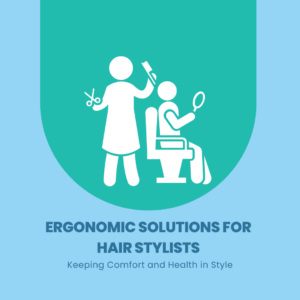Updated: Jul 19, 2024
Ergonomic Solutions for Migraine and Headache Sufferers
For millions of individuals worldwide, migraines and headaches are not just occasional nuisances but chronic conditions that significantly impact daily life. While medical treatments and lifestyle adjustments play crucial roles in managing these conditions, ergonomic solutions can offer additional support by reducing triggers and alleviating symptoms. In this blog, we’ll explore various ergonomic strategies tailored specifically for migraine and headache sufferers, empowering them to find relief and improve their quality of life.
Understanding Migraines and Headaches:
Before delving into ergonomic solutions, it’s essential to understand the nature of migraines and headaches. Migraines are neurological disorders characterized by intense, throbbing pain often accompanied by nausea, sensitivity to light and sound, and visual disturbances. Headaches, on the other hand, encompass a broader spectrum of pain, ranging from mild discomfort to severe tension or cluster headaches.
While the causes of migraines and headaches vary from person to person, certain triggers, such as stress, poor posture, and environmental factors, can exacerbate symptoms or even precipitate an attack. This is where ergonomics comes into play, offering tailored solutions to mitigate these triggers and promote comfort and well-being.
Ergonomic Solutions for Migraine and Headache Relief:
- Optimize Workspace Ergonomics: Whether you’re working in an office setting or telecommuting from home, your workstation setup can significantly impact your migraine and headache symptoms. Consider the following ergonomic adjustments:
- Adjustable Desk and Chair: Invest in an adjustable desk and ergonomic chair that support proper posture and allow you to customize your seated or standing position.
- Monitor Positioning: Position your computer monitor at eye level to reduce strain on your neck and upper back muscles. Adjust the screen brightness and font size to minimize eye strain.
- Task Lighting: Use indirect or diffused lighting to reduce glare and minimize visual discomfort. Avoid harsh overhead lighting or direct sunlight, which can trigger migraines in some individuals.
- Screen Filters: Consider using anti-glare filters or blue light-blocking glasses to reduce eye strain from prolonged screen exposure.
- Take Frequent Breaks: Prolonged periods of concentration or screen time can exacerbate migraine and headache symptoms. Incorporate regular breaks into your work routine to rest your eyes, stretch your muscles, and hydrate. Use the 20-20-20 rule: every 20 minutes, take a 20-second break to look at something 20 feet away.
- Supportive Pillows and Cushions: Maintain proper neck and spinal alignment during rest or sleep by using supportive pillows and cushions. Opt for ergonomic designs that provide adequate support and pressure relief, reducing the risk of tension headaches or neck pain.
- Temperature and Humidity Control: Extreme temperatures or fluctuations in humidity can trigger migraines or exacerbate headache symptoms. Maintain a comfortable indoor environment by regulating temperature and humidity levels, using fans, air purifiers, or humidifiers as needed.
- Stress Management Techniques: Stress is a common trigger for migraines and tension headaches. Incorporate stress management techniques such as deep breathing exercises, meditation, or progressive muscle relaxation to promote relaxation and reduce tension.
- Customized Accessories: Explore ergonomic accessories tailored to your specific needs, such as ergonomic keyboards, mouse pads with wrist support, or footrests. These accessories can help alleviate strain on the wrists, hands, and lower back, reducing the risk of repetitive strain injuries and associated headaches.
- Other accessories include therapeutic interventions to relieve symptoms. These could include blue light glasses such as ones found at TheraSpecs and a cold compression cap from TheraICE.
- Monitor Environmental Triggers: Identify and minimize environmental triggers that may exacerbate your migraine or headache symptoms, such as strong odors, loud noises, or allergens. Create a calm and soothing environment conducive to relaxation and pain management.
- Consult with Healthcare Professionals: If migraines or headaches significantly impact your daily life despite ergonomic interventions, seek guidance from healthcare professionals, such as neurologists, pain specialists, or physical therapists. They can offer personalized treatment plans, including medication, therapy, or alternative therapies, to manage your symptoms effectively.
Remember, finding the right combination of ergonomic solutions may require some experimentation and adaptation to suit your individual needs and preferences. By incorporating these strategies into your daily routine, you can create a supportive environment that promotes comfort, reduces triggers, and empowers you to better manage migraines and headaches. While ergonomic solutions alone may not eliminate migraines or headaches entirely, they can complement existing treatments and contribute to overall well-being and quality of life.
Check out our YouTube video below for a visual representation of the blog!
Oct 21, 2024
Sep 30, 2024
Sep 9, 2024



